Key Questions
...find out more

In order to provide you with the best possible laser eye treatment, we constantly research and invest in the latest technology and equipment ensuring you receive the best results. Here at Visualase we use the iFS Femtosecond Laser by Johnson & Johnson and the SCHWIND Amaris 500E, a highly efficient system with integrated, personalised testing equipment.
To find out more about the technology we use in laser eye surgery and the proven results achieved, click on the tabs below or watch the video from our surgeon Dr Stephen Doyle, Ophthalmologist, MBBS, BSc (Hons), MRCOphth.
The iFS advanced femtosecond laser is built from a legacy of innovative IntraLase technologies which is a proven, trusted, and versatile platform.
Delivers greater precision and predictability for optimal patient outcomes compared to mechanical keratomes.
Modular, upgradeable design allows multiple applications beyond LASIK flaps
The iFS laser system provides you with customisation of all surgical parameters to fit the needs of all patients. Inverted bevel-in side cut up to 150° for optimal biomechanical stability. Elliptical flap option to maximise stromal bed exposure. Lower energy, tighter spot and line separation for smooth stromal beds and easy flap lifts. Reduces risk of infection and lessens patient discomfort, as epithelial integrity is preserved. 3x more flap adhesion strength than the Amadeus® microkeratome7. Increased flap stability post operatively. Fewer dry eye signs and symptoms than with the 30° side cut. Customisable and precise LASIK flap creation. Benefits of inverted bevel-in side cut up to 150° vs standard side cut
Inverted bevel-in side cut, customisable to 150°, promotes flap replacement, positioning, and adhesion for optimal biomechanical stability of the post-LASIK cornea.
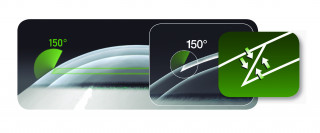
Elliptical flap option maximizes stromal bed exposure for full delivery of excimer ablation. Follows the natural contour of the cornea, allowing the vital lamellar fibres to be preserved during flap creation.
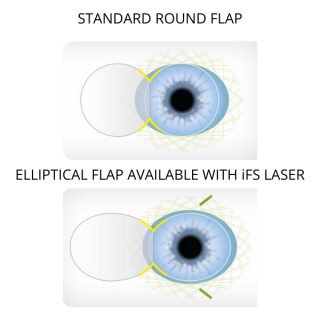
Low energy, tight spot and line separation for smooth stromal beds and easy flap lifts. Reduces risk of infection and lessens patient discomfort, as epithelial integrity is preserved.
Greater precision and customisation.
Allows creation of intrastromal incisions. Individualises each incision using customisable parameters for greater surgical confidence. Allows complete control of angles, placement, and orientations with micron-level accuracy.

The SCHWIND AMARIS 500E perfectly combines efficiency and safety with its compact, ergonomic and mobile design. Automatic Fluence Level Adjustment (AFLA) ensures an optimal balance between the total number of laser pulses and the energy delivered.
The result is fast ablation with optimum smoothing of the cornea. The laser system, with a 500 Hz repetition rate, is perfectly complemented by a 5D eye tracker, which actively compensates for eye movements in five dimensions.
Contact-free online pachymetry measures the thickness of the cornea throughout the entire duration of the laser treatment, and increases intraoperative safety in refractive surgery.
The SCHWIND AMARIS 500E is trusted by eye surgeons, and the outstanding performance of this compact laser system is verified by numerous studies.
The absolute best performance from the leader in technology. The ever-increasing pace of medical advances is a clear indication of the wide range of demands to be met. The result is the new SCHWIND AMARIS product family, which enables us to provide the perfect excimer laser to meet every requirement. Patients have the reassurance of knowing that we are providing the best treatment available. Top performance, precision and efficiency.
The SCHWIND AMARIS offers impressive precision and speed, which redefine perfection in refractive corneal surgery. This provides safety for our patients, short treatment times, but also patient comfort and easy handling throughout the individual stages of treatment. Additional benefits offered by the SCHWIND AMARIS product family as a whole include treatment planning modules for a very wide range of applications.
The SCHWIND AMARIS® family is a fusion of functionality, high performance and safety. Patient expectations are constantly increasing with regard to treatment methods and the results attainable in corneal surgery. This is where the SCHWIND AMARIS family of laser systems sets a new standard, delivering greater safety and patient comfort. In practical terms this means shorter treatment times and minimised risk of corneal dehydration. Moreover, the length of time the patient has to fixate on the green light is significantly shorter. Our laser system is equipped with an extremely high-precision eye tracker, which compensates for eye movements in five dimensions. The laser system offers the combined advantages of tried and tested AMARIS technology – from Automatic Fluence Level Adjustment right through to Intelligent Thermal Effect Control. Contactfree online pachymetry enhances intraoperative safety. And the SCHWIND CAM software facilitates individual and tailor-made treatment planning. All these advantages add up to one thing in particular: safe and perfect results for our patients.
With the Automatic Fluence Level Adjustment (AFLA), the SCHWIND AMARIS product family achieves perfect smoothing of the cornea even at the highest ablation speed.
Researchers at SCHWIND have developed an algorithm that ensures an ideally balanced ratio between the total number of laser pulses and the energy delivered. About 80 percent of the ablation is performed with a high fluence value. For the fine modelling – the remaining 20 percent – AFLA automatically switches to a lower fluence.
The result is optimum smoothing of the cornea. Through the extremely small beam size and Super-Gaussian beam profile, you achieve an exceptionally smooth ablation.
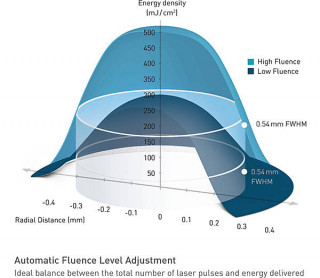
Intelligent Thermal Effect Control (ITEC) is the name of the thermal control process that prevents damage to the surrounding corneal tissue, even at the very high ablation speeds of the SCHWIND AMARIS product family.
ITEC ensures that the laser pulses are distributed in a thermally optimised, dynamically adapted way, which gives the individual position on the cornea sufficient time to cool off.
The following pulses can therefore approach an already cooled position faster. ITEC is clearly superior to the usual static processes. Studies using an infrared thermographic camera have proven that the corneal tissue only heats up minimally, even at high ablation speeds.
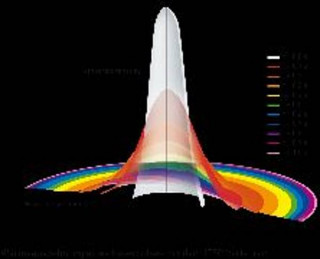
The innovative SCHWIND AMARIS technology combines speed and precision in new dimensions. The 1050 Hz eye tracker actively compensates for every eye movement – in five dimensions, offering an unprecedented level of safety.
On average, the eyes move involuntarily 90 micrometres per millisecond in every direction, even during fixation. Consequently, precise centration and constant positioning of the eye is vitally important if high precision is to be achieved with eye laser surgery.
The eye tracking features of the SCHWIND AMARIS technology ensure maximum safety. Compensation for eye movements in the 1st to 5th dimensions In addition to linear eye movements in the 1st and 2nd dimensions, the advanced eye tracker technology exactly detects and compensates for the horizontal and vertical rolling movements, i.e. the 3rd and 4th dimensions. In the 5th dimension, it compensates for static and dynamic cyclotorsion, or in other words torsional differences between the upright and supine position of the patient as well as rotating movements of the eye during laser treatment.
Features for even more precision
The combination of many advantages in an innovative system makes the SCHWIND AMARIS technology the leading eye-tracking solution.
This includes Pupil Centroid Shift Compensation. Simultaneously with pupil detection, the eye tracker also detects the limbus and considers the pupil shift under different light conditions.
The advantage for the patient: decentration is prevented and no pupildilating medication is necessary prior to treatment. Automatic monitoring of the pupil size during static cyclotorsional control ensures additional safety. The illumination is automatically adjusted so that the pupil remains exactly the same size at the beginning of the treatment as it was at the preoperative examination. Ideal conditions for a perfect outcome with maximum safety – something that only a technology leader is able to offer.
SmartSurf ACE combines the benefits of touch-free TransPRK surface treatment with innovative SmartPulse Technology. It works without touching the eye.
There is no suction, no blade and no incision – vision is precisely corrected through the top layers of the cornea with SCHWIND AMARIS technology, gently, touch-free, in a single step.
SmartSurf ACE corrects refractive errors by superimposing an aspheric ablation profile with a defined epithelial thickness profile. The advantages over other surface treatment methods are obvious – the epithelium is removed more precisely, more uniformly and more easily than with manual or alcohol-assisted debridement.
With regular corneas, treatment with SmartSurf ACE speeds the healing process over other surface treatments. Good vision quality is achieved significantly earlier, even in high myopic eyes. SmartSurf ACE is suitable for any laser candidate as well as patients with thin corneas, corneal pathologies or complex topographies.
The innovative SmartPulse Technology improves vision quality in the early postoperative phase of all treatment methods.
The pulse frequency of 500 Hertz ensures a very short treatment time. One dioptre of myopia is corrected with very high precision in only 2.0 seconds.*
The Automatic Fluence Level Adjustment (AFLA) method ensures an ideally balanced ration between the total number of laser pulses and the energy delivered. About 80 percent of the ablation is performed with a high fluence value. For the fine work – the remaining 20 percent – the laser system automatically switches to a lower fluence.
With the extremely small spot size and the Super-Gaussian beam profile an exceptionally smooth and tissue saving ablation is achieved.
The eye tracker camera monitors the position of the eyes 1050 times per second with a latency time of 1.6 milliseconds.Altogether, the total reaction time of the laser system is only three milliseconds.
The 5D active eye tracker compensates apart from the linear movements (1st and 2nd dimensions) rolling movements of the eye (3rd and 4th dimensions). Compensation of the eye’s rotation around its optical axis is achieved with the static and dynamic Advanced Cyclotorsion Control (5th dimension). Automatic pupil size control and pupil centroid shift compensation ensure additional safety.
For the AMARIS laser, the geometric corneal model, the ablation pulse and the pulse distribution were optimised based on extensive research.
The result: the innovative SmartPulse Technology improves vision quality in the early postoperative phase of all treatment methods.
The thermal control process prevents damage to the surrounding corneal tissue, even at very high ablation speed. ITEC ensures that the laser pulses are distributed in a thermally optimised, dynamically adapted way, which gives the individual position on the cornea sufficient time to cool off. Following pulses can thereby approach an already cooled position faster.
The integrated SCHWIND CAM software with the ORK-CAM, PresbyMAX and PTK-CAM modules offer a tailored treatment planning solution for a uniquely wide range of applications in refractive and therapeutic corneal surgery.
SmartSurfACE combines the benefits of touch-free TransPRK surface treatment with innovative SmartPulse Technology. It works without touching the eye. There is no suction, no blade and no incision - vision is precisely corrected through the top layers of the cornea with SCHWIND AMARIS technology, gently, touch-free, in a single step. SmartSurfACE speeds the healing process over other surface treatments. Good vision is achieved significantly earlier.
The integrated contact-free optical pachymetry provides precise information about the thickness of the cornea throughout the entire duration of the treatment. The changes are measured and displayed on the treatment screen online. The measurements are taken before the preparation and after lifting of the flap, as well as during and after the laser treatment. This increases the intraoperative safety in refractive treatments.
The diagnostic slit lamp for flap checking is compactly designed and can be moved around two axes across the entire working area.
The swivelling patient bed provides added operating comfort. The bed can be used for other stages of treatment without having to change the position of the patient.
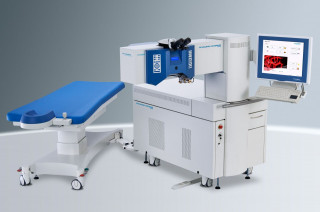
SCHWIND Diagnostic Devices provide an extensive array of measuring methods for refractive and therapeutic corneal surgery.
They offer a multitude of possibilities for individual diagnoses – whether corneal and ocular wavefront data or corneal pachymetry.
SCHWIND CAM software does not miss out a single important detail for the customized treatment planning, which you can conduct on the SCHWIND diagnostic systems or directly on the SCHWIND AMARIS laser system.
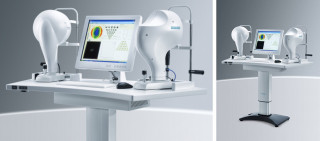
SCHWIND PERAMIS is a multifunctional combination of a state-of-the-art topography device and aberrometer. The optical characteristics of the cornea and entire eye are analysed in a single measuring procedure. The unrivalled performance of the aberrometer is based on a high-resolution pyramid wavefront sensor.
SCHWIND PERAMIS evaluates the ocular wavefront aberrations with an unprecedented 45,000 measuring points – without any overlap and with clear assignment of each point. Together with real-time measurement, this ensures a new level of detail resolution and precision.
The topography device identifies even the smallest corneal irregularities at a very high resolution of one micrometre providing extremely precise diagnosis of corneal and ocular aberrations.
SCHWIND PERAMIS records 33 images per second and automatically selects the image with the best measurement. Furthermore, the topography and aberrometry are measured in a single procedure, so the patient does not need to change the chin rest.
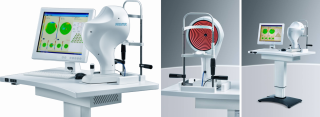
The SCHWIND PERAMIS software offers a whole range of analysis options, including corneal morphology and analysis of ocular and corneal aberrations as well as their direct comparison – whether in tabular form, as a bar graph or as a wavefront map.
Yet another advantage: The high-resolution topography device with placido ring projection provides an extremely accurate corneal curvature values.
Key facts & Features
The unrivalled performance of the aberrometer is based on a high-resolution pyramid wavefront sensor.
SCHWIND PERAMIS evaluates the ocular wavefront aberrations with an unprecedented 45,000 measuring points - without any overlap and with clear assignment of each point.
SCHWIND PERAMIS records 33 images per second and automatically selects the image with the best measurement. Topography and aberrometry are measured in a single procedure. The patient does not need to change the chin rest.
The high-resolution topography device with placido ring projection provides extremely accurate corneal curvature values.
An extensive software package offers a whole range of analysis options - whether in tabular form, as bar diagram or as wavefront map.
SCHWIND SIRIUS offers the perfect combined solution for refractive and therapeutic corneal surgery. The highly precise, multi-functional diagnostic device combines a rotating Scheimpflug camera and a topography device with a placido disc.
The "2 in 1" system provides a quick, three dimensional analysis of the entire cornea and the anterior segment in only one step. The SCHWIND SIRIUS captures the anterior segment in less than one second.
With the high resolution of one micrometre the diagnostic system detects the smallest of irregularities on the anterior corneal surface and therefore offers an extremely precise diagnosis of the aberrations. This non-contact measurement allows the analysis of the total corneal wavefront, the topography of the anterior and posterior corneal surface (including the tangential and axial curvature) as well as the anterior chamber.
Corneal Wavefront Corneal wavefront analysis uses the ray tracing method to document the type and size of all existing optical aberrations in the cornea. These can be viewed separately for the anterior and posterior surface or together for the entire surface of the cornea.
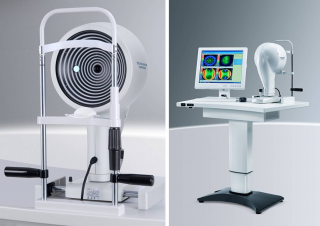
Thanks to the innovative Scheimpflug technology provided by SCHWIND SIRIUS, we have the option to generate an eye's corneal pachymetry map. Accurate information concerning the corneal thickness is essential for performing lasercontrolled ablation.
The integrated pupillometry captures the pupil diameter either dynamically or statically according to the defined lighting conditions.
Key Facts & Features
The "2 in 1" system provides a quick, three-dimensional analysis of the whole cornea and the anterior segment in only one step.
With the high resolution of one micrometre SCHWIND SIRIUS detects the smallest of irregularities.
The contact-free measurement allows an analysis of the complete corneal wavefront, the topography of the anterior and posterior corneal surface (including the tangential and axial curvature) as well as the anterior chamber.
Keratoconus Screening: The SCHWIND SIRIUS offers detailed descriptions of the morphology as well as the classification of the keratoconus.
Thanks to the innovative Scheimpflug technology, an eye's corneal pachymetry map can be generated.
The integrated pupillometry captures the pupil diameter either dynamically or statically according to the defined lighting conditions.
The COMBI WAVEFRONT ANALYZER from SCHWIND integrates a whole range of unique functions and thus contributes to optimal surgical and diagnostic decision-making. The system combines the functions offered by the SCHWIND PERAMIS and SCHWIND SIRIUS.
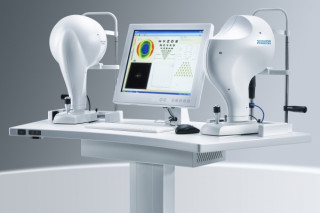
The outstanding detail resolution provides the basis for extensive, particularly precise diagnostics with the COMBI WAVEFRONT ANALYZER. More than 5,632 analysis points and a resolution of 1 µm provide the basis for the corneal wavefront. The aberrometer in the SCHWIND PERAMIS utilises the unique pyramid wavefront sensor to evaluate the ocular wavefront aberrations with up to 45,000 measuring points.
SCHWIND PERAMIS can also be used to compare a patient’s corneal and ocular wavefront data. The direct comparison provides information about whether a visual defect is located on the surface of the cornea or within the eye itself, thus allowing you to identify and evaluate internal aberrations.
In addition, the COMBI WAVEFRONT ANALYZER with SCHWIND SIRIUS provides detailed information on the entire anterior segment of the eye thanks to the Scheimpflug camera.
The same software is used to control both diagnostic systems and evaluate the data, allowing you to view all the data in a common database and compare them directly. The result: a perfect diagnosis tailored specifically to the patient’s personal requirements, and easy, efficient, convenient handling for you.
Key Facts & Features
The COMBI WAVEFRONT ANALYZER combines the functions offered by the SCHWIND PERAMIS and SCHWIND SIRIUS and integrates a whole range of unique functions.
More than 5,632 analysis points and a resolution of 1 µm provide the basis for the corneal wavefront. The aberrometer utilises the unique pyramid wavefront sensor to evaluate the ocular wavefront aberrations with up to 45,000 measuring points.
SCHWIND PERAMIS can also be used to compare a patient's corneal and ocular wavefront data. The direct comparison provides information about whether a a visual defect is located on the surface of the cornea or within the eye itself, thus allowing to identify and evaluate internal aberrations.
In addition, the Combi Wavefront Analyzer with SCHWIND SIRIUS provides detailed information on the entire anterior segment of the eye thanks to the SCHEIMPFLUG camera.
The same software is used to control both diagnostic systems and evaluate the data, allowing you to view all the data in a common database and compare them directly.